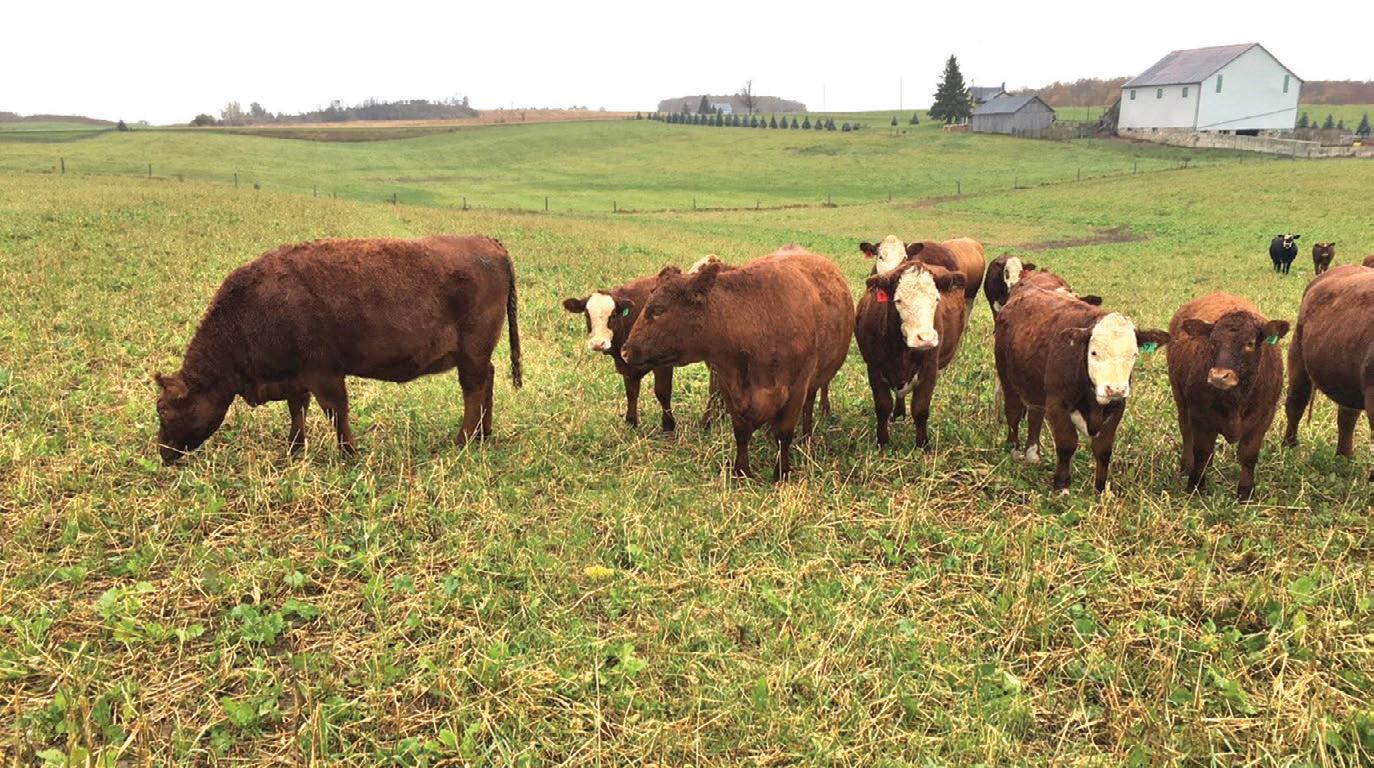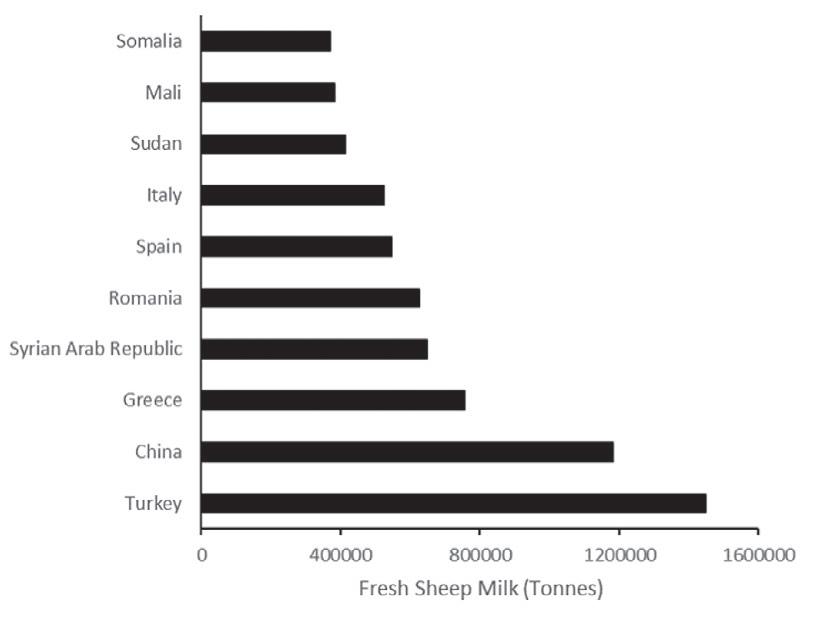
7 minute read
Bennefits of Attending Cover Crop Workshops James Bryne OMAFRA
James Byrne, Beef Cattle Specialist, OMAFRA, Technology adoption
Advertisement
Research by Gabre-Madhin et al, (2003) has workshops since 2017. The workshops provided attendees demonstrated that there is a clear relationship between with the opportunity to see first-hand the benefits of grazing technology adoption by producers and increased cover crops to livestock producers, how effective grazing can farm profitability. Technology adoption includes using new be carried out and some of the challenges encountered. The physical tools, farming methods and ways to analyze farm workshops provided an opportunity for attendees to discuss performance that either directly increase farm output or the practice with the host producers, other attendees and improve productive efficiency leading to increased farm OMAFRA specialists. profitability. Adopting new methods and practices often have a bigger impact on improved farm profitability OMAFRA in collaboration with Beef Farmers of Ontario through greater producer efficiency and Ontario Sheep Farmers will be running a series ofthan a new physical technology, whose benefit is often masked by the Grazing Cover Crop Webinars in November 2020 increased capital cost in acquiring the the uptake of this practice OMAFRA, in collaboration with Beef Farmers of Ontario, have organized several on-farm new technology in the first place. Each workshop involved an on-farm presentation by the host producer and technical presentations from OMAFRA livestock and crop specialists. As the presentations took place in the field, attendees could see, in-person, the cover crop, the cattle grazing the cover crop, grazing management, fencing and how water is provided.
Survey results from the workshops showed that about 70% of attendees have experience with growing cover crops but only 35% graze their cover crops. Of those producers who grazed their cover crops, 90% grazed with Fig. 1. Beef cows and calves grazing a cover crop, OMAFRA/BFO Grazing Cover Crop Workshop, beef cows, where the Elmwood, Ontario. intention was to extend (Photo credit - Andrew Barrie, OMAFRA) the grazing season as late Grazing Cover Crop Workshops remaining 10% of attendees grazed their cover crop with either weaned calves, dry ewes or dairy heifers. When asked
Grazing cover crops is a practice that offers producers what producers planned to do after attending the cover crop the opportunity to increase farm profitability either through workshop, responses were split 50:50 between those who extending the grazing season and therefore reduce the amount hadn’t previously grazed their cover crops but planned to and of stored feed that must be fed or by providing livestock those who either plan to sow a cover crop for the first time or access to high quality pasture, at a time when high quality plan to expand the number of crops sown in their cover crop pasture may be in short supply. To facilitate and promote mixtures. into fall as possible. The
Crop and Livestock Producer Collaboration
Several livestock and cash crop producers at these workshops have indicated their intention to approach their neighbours to discuss the potential of forming a relationship whereby the cover crop grown by a cash crop producer would be available for grazing by the livestock owner. Given the amount of cover crops grown in Ontario, there is significant opportunity for collaboration between cash croppers and livestock owners on grazing cover crops to the mutual benefit of both parties. Collaboration allows the livestock owners to get access to an additional source of grazing to extend the grazing season and reduce winter feeding costs and the cash crop producer can cover the cost of growing the cover crop, have manure spread evenly across the field and have the cover crop partially terminated through the chewing action of the livestock. Provided grazing is well managed, there should be no detrimental effect on ground conditions and no impact on crop yield the subsequent year.
Upcoming Events
OMAFRA in collaboration with Beef Farmers of Ontario and Ontario Sheep Farmers will be running a series of Grazing Cover Crop Webinars in November 2020. More information on registration, agenda, dates and times for these webinars will be available shortly. These webinars will cover the benefits and challenges of growing and grazing cover crops directly from producers with experience of grazing cover crops and hear from OMAFRA specialists on how integrating grazing cover crops into the farming system can improve farm output, reduce costs and boost farm profitability. OSN

Competitive Edge Lamb 22-22-28 Designed specifically for free-choice machine feeding
Is a unique fatty acid technology for immune system support.
Reduces scours Improves ADG Improves feed efficiency Improves frame growth
Contains a higher acidification level to help prevent overeating and limit bacterial growth
Free flowing through milk lines making cleaning and sanitizing easier
Wet Nurse Lamb 24-24-30 Designed for bottle or controlled feeding

www.pmtgroup.com
Wet Nurse™ milk replacers are easy to mix at 40°C and contain high quality, spray dried milk products and a special blend of highly digestible micronized fats that readily disolve when mixed.
It is fortified with optimum levels of water soluble vitamins, chelated trace minerals and organic selenium yeast to enhance development and the overall well-being of the young animal.
Wet Nurse™ Milk Replacers - Providing options specifically designed to meet your every need!
customerservice@pmtgroup.com 1-800-299-7904
Dairy Sheep Milk Worldwide
By Marlene Paibomesai, OMAFRA Dairy Specialist
Sheep milk products are gaining popularity in Canada with more selection of sheep milk cheeses, pasteurized milk, and yogurts at the grocery store. Worldwide sheep milk production has remained relatively constant over the past 5 years with approximately 10,161,633 tonnes and 10,631,057 tonnes fresh sheep milk produced in 2014 and 2018. In 2018, there were approximately 250 million sheep kept for dairy purposes worldwide. Sheep milk is known for its historical and modern-day influence on Mediterranean countries dairy products. The top 10 countries for sheep milk production are shown in Figure 1. Turkey produces the largest amount of sheep milk worldwide, followed by China and Greece (FAO, 2020). Many specialty cheeses made with sheep milk found in Canadian grocery stores including Roquefort, Feta, Peccorino Romano, Manchego, and others.
There are number of sheep breeds that have been bred for dairy traits worldwide including the East Friesian, Lacaune, Sarda, Chios, British Milksheep, White Karaman, Awassi and Assaf. There are other breeds have been developed locally in countries around the world for dairy production with some cheeses only being made with milk from certain sheep breeds. The range of average days in a lactation, yield per lactation and milk components vary amongst these breeds. Days in milk can vary from 150 days to over 250 days in milk. Milk yield can vary from 100 to 700 litres per lactation between the different breeds. Sheep reach peak lactation 6- 8 weeks into the lactation. Breeds like the East Friesian and Lacaune have been bred for milk yield and persistency in lactation.
Dairy sheep production systems worldwide include intensive, semi-extensive and extensive operations. France has well developed genetic improvement program which has been selecting for dairy traits since 1980’s. The first trait selected for was milk yield. Throughout the years there have modules for $200. Module 1 Industry dynamics and governance topics include: Lamb industry – global, North American, Ontario perspectives; Lamb production systems; Lamb supply and price cycles; Sheep industry governance; Sustainable sheep production.
Figure 1. Top ten countries that produce fresh sheep milk in tonnes in 2018. The values represent both Food Agriculture Organization imputation and official data. Data sourced from: FAOStat http://www.fao.org/faostat/en/#data/QL. been other traits selected for including mastitis resistance, female fertility, udder conformation and milk composition. There was a total of 860,000 ewes registered in the genetic improvement program in 2011. Artificial insemination programs are used on 30 to 80% of ewes on farm and vary depending on the breed.

The main dairy sheep breeds in Ontario include East Friesian, Lacuane and British Milksheep. Dairy sheep farms represent less than 1% of milk produced in Ontario. The East Friesian breed was first brought to Ontario in 1994 as embryos. There is very limited collection of data on the number of milking sheep or the number of sheep milk operations in Ontario. More information is needed on the
Master Shepherd’s Course Goes Virtual
Each module will consist of multiple webinars. Producers can still apply to enroll as full course (12 modules) participant for $1750, or for individual size of the sheep milk industry in Ontario. OSN
Module 2-Flock productivity and reproduction topics include: Reproduction, seasonality of estrus, conception rates; Optimizing out-of-season breeding programs; ram management for optimal reproductive success; Culling strategies for improved productivity.
Full details on OSF website /www.ontariosheep.org/mastershepherds-course OSN








